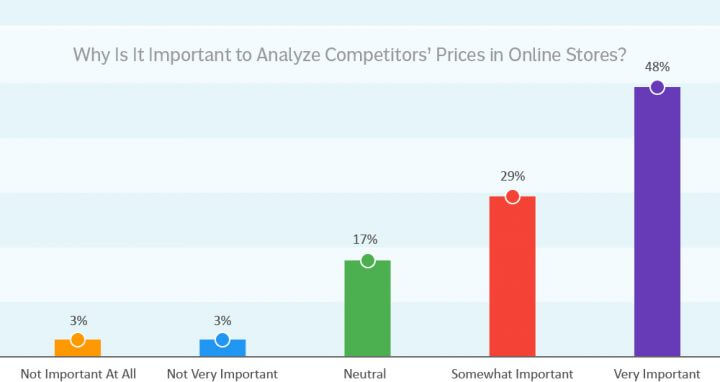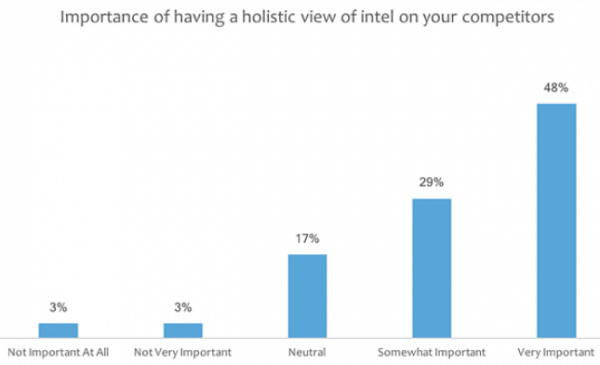
The growth of ecommerce means lots of opportunities for business owners like you. More customers mean more sales, and that is what everyone wants. However, analyzing competitors’ prices in online stores has become quite necessary as there is also the opposite effect of the growth of ecommerce: fierce competition everywhere you look, no matter what product you’re selling.
According to Crayon’s 2018 State of Competitive Intelligence, 77% of companies said that studying the competition and gathering data on them is very important.

**Credits **: Screenshot taken from Impact on August 9, 2019
THE IMPORTANCE OF ANALYZING AND MONITORING PRICES OF COMPETITORS IN ONLINE STORES
The primary goal in monitoring and analyzing the prices of your competitors is to be better than them, always.. This, in essence, is why this particular business process is important. To convince you further, I can give you four specific reasons why you need to monitor and analyze competitors’ prices in online stores:
- It affects advertising success.
- Product prices play a major role in a customer’s decision to buy.
- It gives you an edge over the competition.
- It helps you manage your supply and inventory a lot better.
Now, let us delve into each reason deeper. Take note that the benefits discussed in this section can only be attained if you use the pricing data correctly. Any kind of information can only be powerful and effective if used properly.
PRICE ANALYSIS AND MONITORING AFFECTS ADVERTISING SUCCESS
When you monitor the prices of competitors, you are also in the know of their promotional activities. This can benefit you in two ways:
Learn from market leaders: You can emulate the advertising tactics of the market leaders in the industry you’re in. Of course, you should know who your competitors are, and you should know who the market leaders are.
Learn what’s not working: You can also avoid committing the mistakes that other companies are committing since you will know what they are doing and whether or not it’s effective.
Either way, the most important thing is that you are learning important and actionable things through the data you have gathered and analyzed. Once you know what advertising strategies are working and are failing, you can formulate your own advertising plan.
PRODUCT PRICES AFFECT CUSTOMERS’ BUYING DECISION
The price you set on your products or services can make or break a customer’s decision. For buyers who are conscious about prices, setting the prices high will make them decide not to purchase your product. On the other hand, if you set your price too low, these buyers might adversely think that your product is of low quality, thus the low price.
The latter is also true even when the buyer is not price-conscious (buyers who don’t let the prices of products affect their decisions). The price you set will appear to these buyers as the value you put on your product. The higher the price, the more value you put (but you also run the risk of losing price-conscious customers). If you set the price too low, it will also seem to them as if you aren’t putting enough value on the product, so they don’t see it as valuable enough to purchase.
Here’s a video that can enlighten you about competitive pricing:
All these can be confusing, but it drives an important point: You have to set your price just right. Not too low, not too high. This is where competitors’ price monitoring comes in handy. All the data you collect will inform you about the right price to set, and whether or not it’s time for promotional price changes.
MONITORING COMPETITORS’ PRICES GIVES YOU AN EDGE OVER THEM
Knowing the enemy is half the battle won. This has been often quoted as a variation of Sun Tzu’s famous line that says, “If you know the enemy and know yourself, you need not fear the result of a hundred battles.”
In e-commerce, we say that knowing the competition means having an edge over them. If you know their strategies, prices, strengths, and weaknesses, you are on the winning side. Without knowing these things, you are simply bound to be buried under the hundreds of companies that are offering the same products and services. To put it bluntly, if you don’t study the competition, you are bound to fail.
There is also a need to choose your competition wisely as not every online store can be considered as such. The most obvious choice would be the market leaders in your industry.
KNOWING PRICING TRENDS HELP YOU MANAGE SUPPLY AND INVENTORY
Analyzing the prices set by your competitors will allow you to notice trends in pricing. For instance, after receiving daily price comparison reports, you may notice that the price of Product X is slowly declining. You may decide to go with this trend, and stock up on supply for the particular product since low prices generally creates an increase in demand.
In an opposite scenario, if you notice that Product Y has constantly increased in price over the days you’ve been monitoring it, you can do either of the following tactics:
Increase your price too, and maintain the inventory since you won’t be expecting an increase in sales.
Maintain your price so it will be lower than that of the other online stores. Since your price is lower, you can expect more sales, and increase your inventory.
Either of the two tactics above has their own set of advantages and disadvantages, and your decision should be based on factors other than the price trend. The type of consumer you’re targeting should also be part of the consideration.
HOW TO MONITOR AND ANALYZE COMPETITORS’ PRICES IN ONLINE STORES
Now that you understand the benefits of monitoring and analyzing your competitors’ product prices, it’s time to tackle the method by which this process is done. With competition intensifying day by day, different methods being used in the monitoring and analysis of competitors’ prices are also increasing in number.
However, these methods generally fall into two categories only: Manual and Automated. Below are some insights on each method.
MANUAL MONITORING USING PRICE COMPARISON WEBSITES
Startup businesses usually go for the manual route, but does this really yield real-time and effective data? Let’s find out:
Manual monitoring usually entails the use of price comparison engines such as Google Shopping, Bing Shopping Campaigns, and PriceGrabber. Take note that these search engines are created for shoppers and not for e-commerce business owners looking for big data.
To monitor these price comparison search engines, you would need to hire one or two people who will work 40 hours a week, and you would also need to pay them for their service.
If you require the worker to monitor 100 products from 20 different competitors, he or she will need to process and analyze the data 2,000 times.
Let’s say that the worker is able to finish this in one week. With the constant changes in the market, will the data he collected, processed, and analyzed still relevant by the time the worker submits it to you?
With the intense competition in the market, the effectiveness of any research data depends on its relevance and timeliness. Manual monitoring incur cost but the data gathered may not be relevant any more since it takes time to complete. Therefore, it can very well be considered a waste of resources - in terms of finances and human resources.
AUTOMATED MONITORING USING PRICE COMPARISON TOOLS
Online businesses who have been in the industry long enough, have learned the disadvantages of manual price monitoring and the importance of time-relevant reports. For this reason, they invest in price comparison software or tools such as Prisync and Smartprix. These automated tools are less of a hassle and can save business owners on labor cost as there’s no need to check product links of competitors.
Price comparison tools are usually cloud-based solutions that can be configured to give out multiple reports everyday. This feature is necessary since market prices are being changed on a daily basis also.
CONCLUSION
Analyzing and monitoring competitors’ prices online is a necessity for an e-commerce business to succeed. Equally important is how you are going to use the data you gathered, as it can dictate the success of your advertising and pricing strategies. The price you set based on all the data you processed and analyzed will also affect your customers’ decision of whether or not to buy from you or from your competitor.
The method by which you monitor your competitors’ prices also plays a crucial role since you need the data to be time-relevant and not outdated. For this reason, using automation tools is the best way to go.
Automated price comparison software and tools help make the process easier and more time efficient, and like any automation tools, they are best used together with a proxy service like LimeProxies to avoid getting blocked and to protect your business too. The benefits of using a price comparison tool with a proxy far outweighs the disadvantage of an outdated data obtained from manual monitoring of competitors’ prices.
Post Quick Links
Jump straight to the section of the post you want to read:
6 BEST BROWSER AUTOMATION TOOLS FOR WEB SCRAPING
Browser Automation Tools for Web Scraping are developed to make testing activities including web scraping easier and more accurate. To some people, web scraping may sound dubious, but a lot of organizations actually do it for several legitimate purposes.


About the author
Rachael Chapman
A Complete Gamer and a Tech Geek. Brings out all her thoughts and Love in Writing Techie Blogs.
Related Articles
What is the impact of Edward Snowden on the World?
An American citizen named Edward Snowden gave away information that contained documents from the National Security Agency to a journalist from The Guardian in June 2013. The documents were concerned with domestic spying
11 Most Frequently Asked Web scraping questions by market researchers Answered
There are a lot of things that you can do with data scraping. 11 Most Frequently Asked Web scraping questions by market researchers Answered